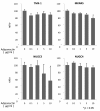Adiponectin receptor-1 expression is associated with good prognosis in gastric cancer
- PMID: 22078265
- PMCID: PMC3223499
- DOI: 10.1186/1756-9966-30-107
Adiponectin receptor-1 expression is associated with good prognosis in gastric cancer
Abstract
Background: Adiponectin is inversely related to BMI, positively correlates with insulin sensitivity, and has anti-atherogenic effects. In recent years, adiponectin has been well studied in the field of oncology. Adiponectin has been shown to have antiproliferative effects on gastric cancer, and adiponectin expression is inversely correlated with clinical staging of the disease. However, no studies have reported the correlation between serum adiponectin and receptor expression with disease progression.
Methods: In this study, we evaluated expression levels of 2 adiponectin receptors--AdipoR1 and AdipoR2--and attempted to correlate their expression with prognosis in gastric cancer patients. AdipoR1 and AdipoR2 expression in gastric cancer cell lines (MKN45, TMK-1, NUGC3, and NUGC4) was evaluated by western blotting analysis, and the antiproliferative potential of adiponectin was examined in vitro. Serum adiponectin levels were evaluated in 100 gastric cancer patients, and the expression of AdipoR1 and AdipoR2 was assessed by immunohistochemical staining.
Results: MKN45 and NUGC3 expressed higher levels of AdipoR1 compared to NUGC4, even though there was no significance in AdipoR2 expression. The antiproliferative effect of adiponectin was confirmed in MKN45 and NUGC3 at 10 μg/ml. No significant associations were observed between serum adiponectin levels and clinicopathological characteristics, but lymphatic metastasis and peritoneal dissemination were significantly higher in the negative AdipoR1 immunostaining group (24/32, p = 0.013 and 9/32, p = 0.042, respectively) compared to the positive AdipoR1 group (lymphatic metastasis, 33/68; peritoneal dissemination, 8/68). On the other hand, AdipoR2 expression was only associated with histopathological type (p = 0.001). In survival analysis, the AdipoR1 positive staining group had significantly longer survival rates than the negative staining group (p = 0.01). However, multivariate analysis indicated that AdipoR1 was not an independent prognostic factor on patient's survival on gastric cancer.
Conclusions: In gastric cancer, adiponectin has the possibility to be involved in cell growth suppression via AdipoR1. The presence of AdipoR1 could be a novel anticancer therapeutic target in gastric cancer.
Figures







Similar articles
-
Adiponectin receptor expression in gastric carcinoma: implications in tumor development and progression.J Cancer Res Clin Oncol. 2013 Apr;139(4):709-18. doi: 10.1007/s00432-013-1379-3. Epub 2013 Jan 29. J Cancer Res Clin Oncol. 2013. PMID: 23358721 Free PMC article.
-
Adiponectin receptors are downregulated in human gastric cancer.J Gastroenterol. 2010 Sep;45(9):918-27. doi: 10.1007/s00535-010-0228-2. Epub 2010 Mar 25. J Gastroenterol. 2010. PMID: 20336470
-
Adiponectin and adiponectin receptor in relation to colorectal cancer progression.Int J Cancer. 2010 Dec 15;127(12):2758-67. doi: 10.1002/ijc.25301. Int J Cancer. 2010. PMID: 21351255 Clinical Trial.
-
[Adiponectin receptor regulation in diabetic states].Nihon Rinsho. 2007 Nov;65(11):2125-30. Nihon Rinsho. 2007. PMID: 18018580 Review. Japanese.
-
Adiponectin as a Potential Therapeutic Target for Prostate Cancer.Curr Pharm Des. 2017;23(28):4170-4179. doi: 10.2174/1381612823666170208123553. Curr Pharm Des. 2017. PMID: 28183249 Free PMC article. Review.
Cited by
-
The role of adiponectin in cancer: a review of current evidence.Endocr Rev. 2012 Aug;33(4):547-94. doi: 10.1210/er.2011-1015. Epub 2012 Apr 30. Endocr Rev. 2012. PMID: 22547160 Free PMC article. Review.
-
Should visceral fat, strictly linked to hepatic steatosis, be depleted to improve survival?Hepatol Int. 2013 Jun;7(2):413-28. doi: 10.1007/s12072-012-9406-z. Epub 2012 Oct 26. Hepatol Int. 2013. PMID: 26201775
-
High expression of 5-hydroxymethylcytosine and isocitrate dehydrogenase 2 is associated with favorable prognosis after curative resection of hepatocellular carcinoma.J Exp Clin Cancer Res. 2014 Apr 10;33(1):32. doi: 10.1186/1756-9966-33-32. J Exp Clin Cancer Res. 2014. PMID: 24716838 Free PMC article.
-
Adiponectin receptor expression in gastric carcinoma: implications in tumor development and progression.J Cancer Res Clin Oncol. 2013 Apr;139(4):709-18. doi: 10.1007/s00432-013-1379-3. Epub 2013 Jan 29. J Cancer Res Clin Oncol. 2013. PMID: 23358721 Free PMC article.
-
Esophageal adenocarcinoma and obesity: peritumoral adipose tissue plays a role in lymph node invasion.Oncotarget. 2015 May 10;6(13):11203-15. doi: 10.18632/oncotarget.3587. Oncotarget. 2015. PMID: 25857300 Free PMC article.
References
-
- Nakano Y, Tobe T, Choi-Miura NH, Mazda T, Tomita M. Isolation and characterization of GBP28, a novel gelatin-binding protein purified from human plasma. J Biochem. 1996;120:803–812. - PubMed
MeSH terms
Substances
LinkOut - more resources
Full Text Sources
Medical

